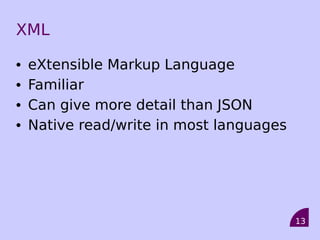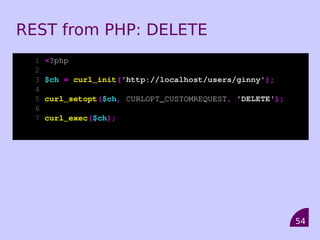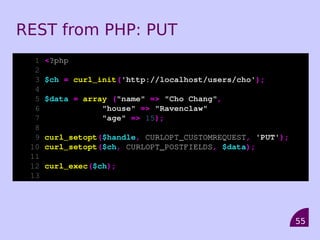Working with web_services
- 2. Who am I? • Lorna Mitchell • PHP Specialist • Developer, Writer, Consultant, Trainer • Personal site at lornajane.net • Twitter: @lornajane • PHPNW, PHPWomen 2
- 3. Working with Web Services • Consuming existing services • Web services overview • Data types • Service types • Debugging • Using services from PHP 3
- 4. What are Web Services? • Machine-friendly applications • Formatted data instead of a web page 4
- 5. Why Do We Care? • Web services let us exchange data – between systems – within systems • Architecture looks like library or module boundary • Sharing information between systems cleanly 5
- 6. How do Web Services Work? • Client/Server • Sound familiar? • Request and response, just like a web application • Same theories apply 6
- 7. When Things Go Wrong • Errors will appear in response • We may not expect them • Apache logs • Debug output and logging • Verbose error-checking and logging from our app • Graceful failure 7
- 8. Data Formats 8
- 9. JSON • JavaScript Object Notation • Natively read/write in most languages • Very simple! (we like simple) • Limitations – no data typing – no distinction between object and array 9
- 10. Writing JSON from PHP 1 <?php 2 3 $menu['starter'] = array( "prawn cocktail", 4 "soup of the day"); 5 $menu['main course'] = array( "roast chicken", 6 "fish 'n' chips", 7 "macaroni cheese"); 8 $menu['pudding'] = array( "cheesecake", 9 "treacle sponge"); 10 11 echo json_encode($menu); {"starter":["prawn cocktail","soup of the day"],"main course":["roast chicken","fish 'n' chips","macaroni cheese"],"pudding":["cheesecake","treacle sponge"]} 10
- 11. Reading JSON from PHP 1 <?php 2 3 $json = '{"starter":["prawn cocktail","soup of the day"],"main course":["roast chicken","fish 'n' chips","macaroni cheese"],"pudding":["cheesecake","treacle sponge"]}'; 4 5 print_r(json_decode($json)); 11
- 12. Reading JSON from PHP stdClass Object ( [starter] => Array ( [0] => prawn cocktail [1] => soup of the day ) [main course] => Array ( [0] => roast chicken [1] => fish 'n' chips [2] => macaroni cheese ) [pudding] => Array ( [0] => cheesecake [1] => treacle sponge ) 12 )
- 13. XML • eXtensible Markup Language • Familiar • Can give more detail than JSON • Native read/write in most languages 13
- 14. Working with XML from PHP • Lots of options • SimpleXML • DOM 14
- 15. SimpleXML Example 1 <?php 2 3 $xml = <<< XML 4 <?xml version="1.0" ?> 5 <menus> 6 <menu>Lunch</menu> 7 <menu>Dinner</menu> 8 <menu>Dessert</menu> 9 <menu>Drinks</menu> 10 </menus> 11 XML; 12 13 $simplexml = new SimpleXMLElement($xml); 14 var_dump($simplexml); 15
- 16. SimpleXML Example object(SimpleXMLElement)#1 (1) { ["menu"]=> array(5) { [0]=> string(5) "Lunch" [1]=> string(6) "Dinner" [2]=> string(7) "Dessert" [3]=> string(6) "Drinks" } } 16
- 17. SimpleXML Example 1 <?php 2 3 $simplexml = simplexml_load_string('<?xml version="1.0" ?><menus/>'); 4 $simplexml->addChild('menu','Lunch'); 5 $simplexml->addChild('menu','Dinner'); 6 $simplexml->addChild('menu','Drinks'); 7 $simplexml->addChild('menu','Dessert'); 8 9 echo $simplexml->asXML(); 17
- 18. SimpleXML Example <?xml version="1.0"?> <menus> <menu>Lunch</menu> <menu>Dinner</menu> <menu>Dessert</menu> <menu>Drinks</menu> </menus> 18
- 19. Serialised PHP • Native to PHP • Useful for values in database • Can also use to move data between PHP applications 19
- 20. Serialising Data in PHP 1 <?php 2 3 $menu['starter'] = array( "prawn cocktail", 4 "soup of the day"); 5 $menu['main course'] = array( "roast chicken", 6 "fish 'n' chips", 7 "macaroni cheese"); 8 $menu['pudding'] = array( "cheesecake", 9 "treacle sponge"); 10 11 echo serialize($menu); a:3:{s:7:"starter";a:2:{i:0;s:14:"prawn cocktail";i:1;s:15:"soup of the day";}s:11:"main course";a:3:{i:0;s:13:"roast chicken";i:1;s:14:"fish'n' chips";i:2;s:15:"macaroni cheese";}s:7:"pudding";a:2: {i:0;s:10:"cheesecake";i:1;s:14:"treacle sponge";}} 20
- 21. Unserialising Data in PHP 1 <?php 2 3 $serialised = 'a:3:{s:7:"starter";a:2:{i:0;s:14:"prawn cocktail";i:1;s:15:"soup of the day";}s:11:"main course";a:3:{i:0;s:13:"roast chicken";i:1;s:14:"fish 'n' chips";i:2;s:15:"macaroni cheese";}s:7:"pudding";a:2: {i:0;s:10:"cheesecake";i:1;s:14:"treacle sponge";}}'; 4 5 var_dump(unserialize($serialised)); 21
- 22. Unserialising Data in PHP array(3) { ["starter"]=> array(2) { [0]=> string(14) "prawn cocktail" [1]=> string(15) "soup of the day" } ["main course"]=> array(3) { [0]=> string(13) "roast chicken" [1]=> string(14) "fish 'n' chips" [2]=> string(15) "macaroni cheese" } ["pudding"]=> array(2) { [0]=> string(10) "cheesecake" [1]=> string(14) "treacle sponge" } 22 }
- 23. Service Types
- 24. Service Types • SOAP • *-RPC – XML-RPC – JSON-RPC • REST 24
- 25. SOAP • Just "soap" • Defined XML format • Also includes definition for error format • Wrappers available for most languages • Optionally uses a WSDL to describe the service – Web Service Description Language 25
- 26. Example WSDL <?xml version ='1.0' encoding ='UTF-8' ?> <definitions name='MyClass' targetNamespace='urn:MyClassInventory' xmlns:tns='urn:MyClassInventory' xmlns:soap='http://schemas.xmlsoap.org/wsdl/soap/' xmlns:xsd=' http://www.w3.org/2001/XMLSchema' xmlns:soapenc='http://schemas.xmlsoap.org/soap/encoding/' xmlns:wsdl='http://schemas.xmlsoap.org/wsdl/' xmlns='http://schemas.xmlsoap.org/wsdl/'> <message name='getAccountStatusRequest'> <part name='accountID' type='xsd:string'/> </message> <message name='getAccountStatusResponse'> <part name='accountID' type='xsd:string'/> <part name='counter' type='xsd:float' /> </message> <portType name='MyClassPortType'> <operation name='getAccountStatus'> <input message='tns:getAccountStatusRequest'/> <output message='tns:getAccountStatusResponse'/> </operation> </portType> <binding name='MyClassBinding' type='tns:MyClassPortType'> <soap:binding style='rpc' transport='http://schemas.xmlsoap.org/soap/http'/> <operation name='getAccountStatus'> <soap:operation soapAction='urn:xmethods-delayed-quotes#getAccountStatus'/> <input> <soap:body use='encoded' namespace='urn:xmethods-delayed-quotes' encodingStyle='http://schemas.xmlsoap.org/soap/encoding/'/> </input> <output> <soap:body use='encoded' namespace='urn:xmethods-delayed-quotes' encodingStyle='http://schemas.xmlsoap.org/soap/encoding/'/> </output> </operation> </binding> <service name='MyClassService'> <port name='MyClassPort' binding='tns:MyClassBinding'> <soap:address location='http://rivendell.local:10002/MyClassServiceServer.php'/> </port> </service> </definitions> 26
- 27. WSDL tips • Read from end to beginning 1.Service location and name 2.Method names and bindings 3.Details of request/response messages 4.Variable names and data types used for each request/response 5.Data type definitions 6.Namespace information 27
- 28. PHP SOAP Client Example 1 <?php 2 3 ini_set('soap.wsdl_cache_enabled','0'); 4 5 require_once('lib/Snapshot.php'); 6 7 $wsdl = "Service.wsdl"; 8 $client = new SoapClient($wsdl, $params); 9 10 $output = $client->requestShot( 11 'http://www.php.net','', 300, 400); 28
- 29. Troubleshooting SOAP • Check request – $client->getLastRequest() • Check request headers – $client->getLastRequestHeaders() • Check WSDL • Data types can be an issue between different client/server languages 29
- 30. HTTP Debugging Tools • cURL – http://curl.haxx.se/ • Wireshark – http://www.wireshark.org/ • Charles – http://www.charlesproxy.com/ 30
- 31. cURL • cURL is a command-line tool • Simple but powerful • Specify HTTP verb • Observe full request/response headers • Handle cookies 31
- 32. cURL Cheat Sheet • curl http://localhost • -v to show request/response • -I to show response headers • -X to specify HTTP method • -d to add a data field • -c to store cookies in a cookiejar • -b to use a cookiejar with request 32
- 33. Wireshark Examples 33
- 34. Wireshark Examples 34
- 35. Wireshark Examples 35
- 36. Wireshark Examples 36
- 37. RPC Services • Remote Procedure Call • Similar to library • Call function with arguments 37
- 38. Example RPC services • Using Flickr's XML-RPC • Test method: just echoes back to user • XML formatted data 38
- 39. Flickr Echo Example: XML <?xml version="1.0"?> <methodCall> <methodName>flickr.test.echo</methodName> <params> <param> <value> <struct> <member> <name>api_key</name> <value>....</value> </member> </struct> </value> </param> </params> </methodCall> 39
- 40. RPC from PHP: curl 1 <?php 2 3 // $xml is existing SimpleXMLElement Object 4 $url = 'http://api.flickr.com/services/xmlrpc/'; 5 $ch = curl_init($url); 6 7 curl_setopt($ch, CURLOPT_POST, 1); 8 curl_setopt($ch, CURLOPT_POSTFIELDS, $xml->asXML()); 9 10 $response = curl_exec($ch); 11 curl_close($ch); 40
- 41. RPC from PHP: pecl_http 1 <?php 2 3 $url = 'http://api.flickr.com/services/xmlrpc/'; 4 5 // procedural method 6 $response = http_post_data($url, $xml->asXML()); 7 8 // alternative method 9 $request = new HTTPRequest($url, HTTP_METH_POST); 10 $request->setRawPostData($xml->asXML()); 11 $request->send(); 12 $response = $request->getResponseBody(); 13 14 var_dump($response); 41
- 42. Flickr Response <?xml version="1.0" encoding="utf-8" ?> <methodResponse> <params> <param> <value> <string><api_key>54rt346</api_key> </string> </value> </param> </params> </methodResponse> 42
- 43. Wrapping RPC • RPC is a library-like interface • Can easily wrap existing libraries to call like this • Can wrap an interface to an RPC service to look like a library 43
- 44. Wrapping RPC Example 1 <?php 2 3 class Handler 4 { 5 function __call($method, $args) { 6 $ch = curl_init('http://localhost'); 7 $data['method'] = $method; 8 foreach($args as $a) $data[$a] = $a; 9 10 curl_setopt($ch, CURLOPT_POST,1); 11 curl_setopt($ch, CURLOPT_POSTFIELDS, $data); 12 $response = curl_exec($ch); curl_close($ch); 13 14 var_dump($response); 15 } 16 } 17 $h = new Handler(); 18 $h->dance('cat','dog','rabbit','penguin'); 44 19
- 45. Troubleshooting RPC • Break down into smallest steps • Can you get a response from the service? • Can you log in? • Is there an error? • Try to debug the details of the request/response 45
- 46. REST • REpresentational State Transfer • Not a protocol • More like a philosophy 46
- 47. REST Overview • A series of concepts • Generally uses HTTP (HyperText Transfer Protocol) • URLs are resource locations • Verbs tell the service what to do • Status codes indicate what the outcome was 47
- 48. HTTP Status Codes Code Meaning 200 OK 302 Found 301 Moved 401 Not Authorised 403 Forbidden 404 Not Found 500 Internal Server Error 48
- 49. REST CRUD Action HTTP Verb Retrieve GET Create POST Update PUT Delete DELETE 49
- 50. REST Examples • GET – http://localhost/users – http://localhost/users/harry • POST – http://localhost/users • PUT – http://localhost/users/harry • DELETE – http://localhost/users/harry 50
- 51. REST from PHP: GET 1 <?php 2 3 $result = file_get_contents('http://localhost/users'); 4 var_dump($result); 51
- 52. REST from PHP: GET 1 <?php 2 3 $ch = curl_init('http://localhost/users'); 4 5 curl_exec($ch); • Health Warning! – curl will echo output – use CURLOPT_RETURNTRANSFER to capture it instead 52
- 53. REST from PHP: POST 1 <?php 2 3 $ch = curl_init('http://localhost/users'); 4 5 $data = array ("name" => "Cho Chang", 6 "house" => "Ravenclaw"); 7 8 curl_setopt($ch, CURLOPT_POST, 1); 9 curl_setopt($ch, CURLOPT_POSTFIELDS, $data); 10 11 curl_exec($ch); 53
- 54. REST from PHP: DELETE 1 <?php 2 3 $ch = curl_init('http://localhost/users/ginny'); 4 5 curl_setopt($ch, CURLOPT_CUSTOMREQUEST, 'DELETE'); 6 7 curl_exec($ch); 54
- 55. REST from PHP: PUT 1 <?php 2 3 $ch = curl_init('http://localhost/users/cho'); 4 5 $data = array ("name" => "Cho Chang", 6 "house" => "Ravenclaw" 7 "age" => 15); 8 9 curl_setopt($handle, CURLOPT_CUSTOMREQUEST, 'PUT'); 10 curl_setopt($ch, CURLOPT_POSTFIELDS, $data); 11 12 curl_exec($ch); 13 55
- 56. Troubleshooting REST • Does resource exist? • Is there a status code? • What does the response body look like? • Intercept web traffic • Use command line curl 56
- 57. Working with Web Services
- 58. Working with Web Services • Consuming existing services • Web services overview • Data types • Service types • Debugging • Using services from PHP 58
- 59. Top tips • If your app can't talk to the service, can you get closer to the service? • If you control both server and client, add debug output • Use proxies to record what happens • Start with the lowest common denominator and work up 59
- 60. Questions?
- 61. Thankyou! Twitter: @lornajane Website: http://lornajane.net









![Writing JSON from PHP
1 <?php
2
3 $menu['starter'] = array( "prawn cocktail",
4 "soup of the day");
5 $menu['main course'] = array( "roast chicken",
6 "fish 'n' chips",
7 "macaroni cheese");
8 $menu['pudding'] = array( "cheesecake",
9 "treacle sponge");
10
11 echo json_encode($menu);
{"starter":["prawn cocktail","soup of the day"],"main
course":["roast chicken","fish 'n' chips","macaroni
cheese"],"pudding":["cheesecake","treacle sponge"]}
10](https://image.slidesharecdn.com/workingwithwebservices-100822071900-phpapp01/85/Working-with-web_services-10-320.jpg)
![Reading JSON from PHP
1 <?php
2
3 $json = '{"starter":["prawn cocktail","soup of the
day"],"main course":["roast chicken","fish 'n'
chips","macaroni cheese"],"pudding":["cheesecake","treacle
sponge"]}';
4
5 print_r(json_decode($json));
11](https://image.slidesharecdn.com/workingwithwebservices-100822071900-phpapp01/85/Working-with-web_services-11-320.jpg)
![Reading JSON from PHP
stdClass Object
(
[starter] => Array
(
[0] => prawn cocktail
[1] => soup of the day
)
[main course] => Array
(
[0] => roast chicken
[1] => fish 'n' chips
[2] => macaroni cheese
)
[pudding] => Array
(
[0] => cheesecake
[1] => treacle sponge
)
12
)](https://image.slidesharecdn.com/workingwithwebservices-100822071900-phpapp01/85/Working-with-web_services-12-320.jpg)



![SimpleXML Example
object(SimpleXMLElement)#1 (1) {
["menu"]=>
array(5) {
[0]=>
string(5) "Lunch"
[1]=>
string(6) "Dinner"
[2]=>
string(7) "Dessert"
[3]=>
string(6) "Drinks"
}
}
16](https://image.slidesharecdn.com/workingwithwebservices-100822071900-phpapp01/85/Working-with-web_services-16-320.jpg)



![Serialising Data in PHP
1 <?php
2
3 $menu['starter'] = array( "prawn cocktail",
4 "soup of the day");
5 $menu['main course'] = array( "roast chicken",
6 "fish 'n' chips",
7 "macaroni cheese");
8 $menu['pudding'] = array( "cheesecake",
9 "treacle sponge");
10
11 echo serialize($menu);
a:3:{s:7:"starter";a:2:{i:0;s:14:"prawn
cocktail";i:1;s:15:"soup of the day";}s:11:"main
course";a:3:{i:0;s:13:"roast chicken";i:1;s:14:"fish'n'
chips";i:2;s:15:"macaroni cheese";}s:7:"pudding";a:2:
{i:0;s:10:"cheesecake";i:1;s:14:"treacle sponge";}}
20](https://image.slidesharecdn.com/workingwithwebservices-100822071900-phpapp01/85/Working-with-web_services-20-320.jpg)

![Unserialising Data in PHP
array(3) {
["starter"]=>
array(2) {
[0]=>
string(14) "prawn cocktail"
[1]=>
string(15) "soup of the day"
}
["main course"]=>
array(3) {
[0]=>
string(13) "roast chicken"
[1]=>
string(14) "fish 'n' chips"
[2]=>
string(15) "macaroni cheese"
}
["pudding"]=>
array(2) {
[0]=>
string(10) "cheesecake"
[1]=>
string(14) "treacle sponge"
} 22
}](https://image.slidesharecdn.com/workingwithwebservices-100822071900-phpapp01/85/Working-with-web_services-22-320.jpg)





















![Wrapping RPC Example
1 <?php
2
3 class Handler
4 {
5 function __call($method, $args) {
6 $ch = curl_init('http://localhost');
7 $data['method'] = $method;
8 foreach($args as $a) $data[$a] = $a;
9
10 curl_setopt($ch, CURLOPT_POST,1);
11 curl_setopt($ch, CURLOPT_POSTFIELDS, $data);
12 $response = curl_exec($ch); curl_close($ch);
13
14 var_dump($response);
15 }
16 }
17 $h = new Handler();
18 $h->dance('cat','dog','rabbit','penguin'); 44
19](https://image.slidesharecdn.com/workingwithwebservices-100822071900-phpapp01/85/Working-with-web_services-44-320.jpg)
















